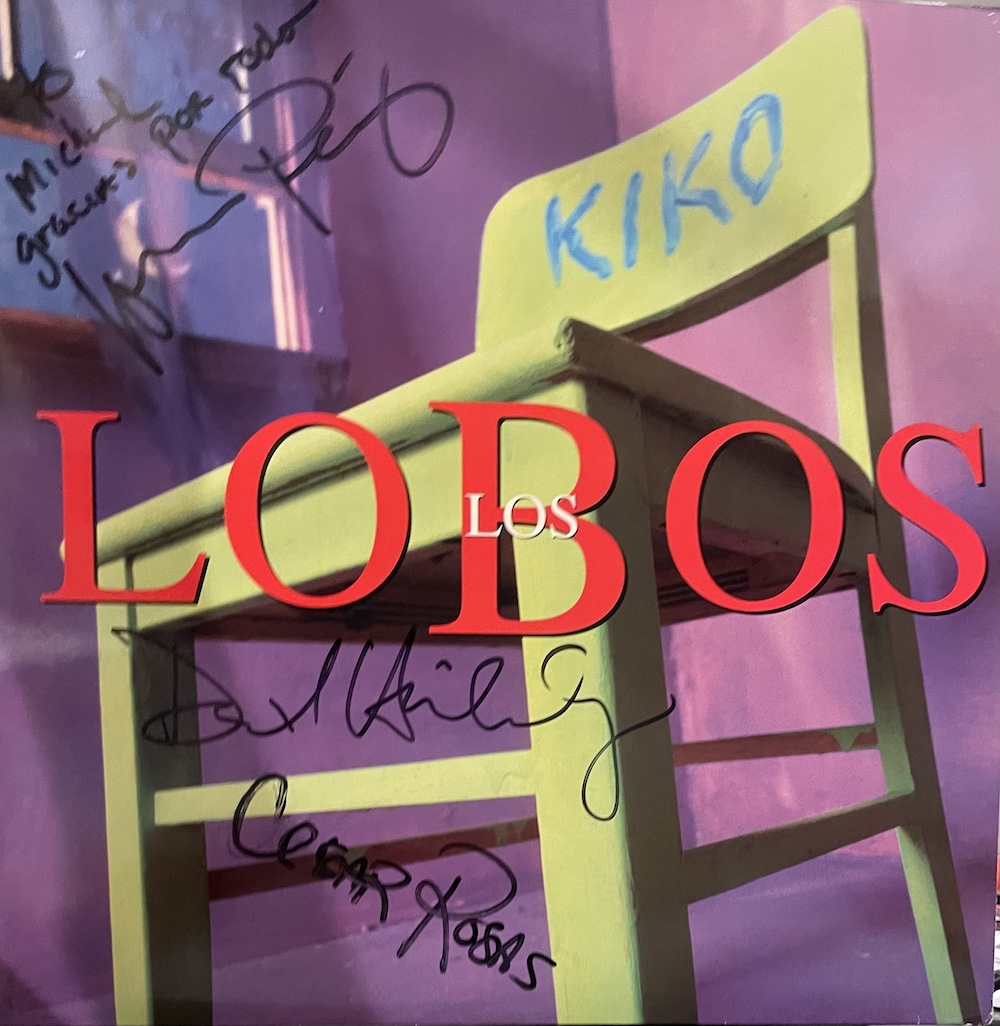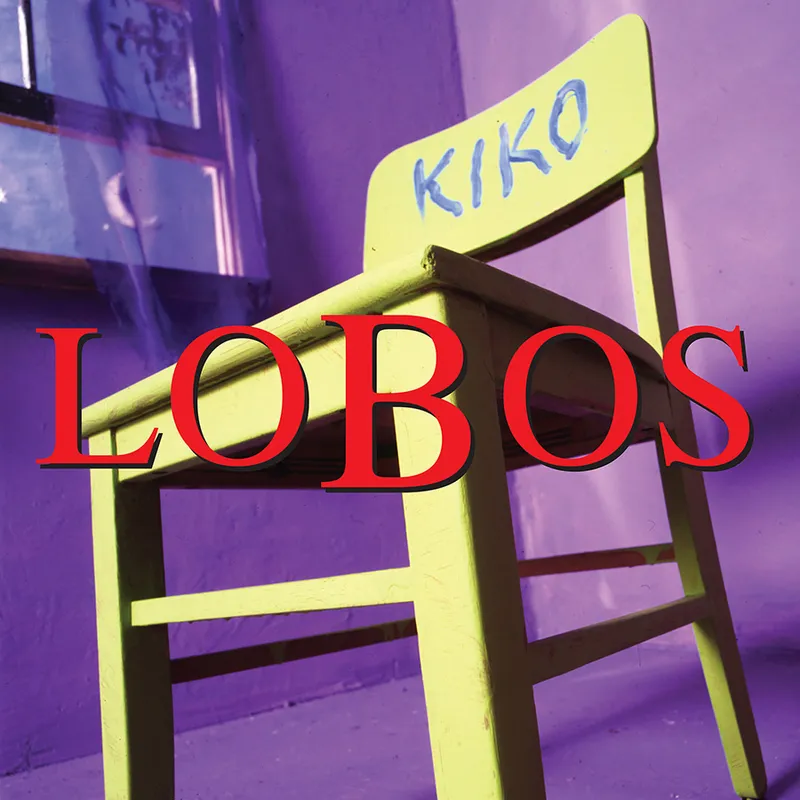Los Lobos's "Kiko" Gets Its Best Vinyl Reissue
RSD "Black Friday" release mastered by our Dave McNair
Is it a "conflict of interest" to review a record mastered by a Tracking Angle writer? I could care less. This is mastering engineer Dave McNair's second pass on Kiko, Los Lobos' best selling (other than the La Bamba soundtrack) and arguable best album. Though recorded analog and mixed to 2 inch 30IPS tape, It was originally released domestically on CD only in 1992 during vinyl's sunset fade. It got a digitally sourced European release that squeezed the whole thing on to two sides. It was worth getting "just because", and it was sure convenient to have it when I interviewed the band back in 2004 for The Tracking Angle print magazine, so I could get it autographed.
 You may have noticed the source for this release was a digital file produced from the 30 IPS 1/2" master tape and wonder why Dave McNair couldn't just use the tape. He was actually offered it but even had he gotten it he couldn't have duplicated the original CD's cross fades (produced back then by Dave Collins who put the mixes into a digital work station and produced a 48k/16 bit DAT master).
You may have noticed the source for this release was a digital file produced from the 30 IPS 1/2" master tape and wonder why Dave McNair couldn't just use the tape. He was actually offered it but even had he gotten it he couldn't have duplicated the original CD's cross fades (produced back then by Dave Collins who put the mixes into a digital work station and produced a 48k/16 bit DAT master).
Dave McNair told me he could have done his mastering work (EQ, compression etc.) in the digital domain but preferred the sound of his analog EQ and compressor so did it that way. Here's his flow chart comparing the original CD production and his:
 Following the Mobile Fidelity DSD disclosure and lawsuit, Mobile Fidelity posted to its website the sources for all releases. Re: Kiko, the site discloses this: "Digital clone of original PCM digital master to analog console to lathe." No analog at all other than console to lathe. But whatever: at a show last year Dave had a lacquer he'd cut from his mastered file and it sonically obliterated the Mo-Fi LP sound particularly the equalization. Yes, trolls, I did give the Mo-Fi a great review because it was great compared to the U.K. LP I had. But when McNair compared his lacquer to the Mo-Fi it was no contest—and not because one was a lacquer. Dave's EQ choices were far superior: more open, more rockin' less "audiophile".
Following the Mobile Fidelity DSD disclosure and lawsuit, Mobile Fidelity posted to its website the sources for all releases. Re: Kiko, the site discloses this: "Digital clone of original PCM digital master to analog console to lathe." No analog at all other than console to lathe. But whatever: at a show last year Dave had a lacquer he'd cut from his mastered file and it sonically obliterated the Mo-Fi LP sound particularly the equalization. Yes, trolls, I did give the Mo-Fi a great review because it was great compared to the U.K. LP I had. But when McNair compared his lacquer to the Mo-Fi it was no contest—and not because one was a lacquer. Dave's EQ choices were far superior: more open, more rockin' less "audiophile".
McNair convinced Rhino/Warner Music to spread the record onto two LPs of this three LP set, which was a great idea and glad they went along. The third record contains a side of outtakes and a side of jams.
Dave couldn't cut the actual lacquers for this release because in technical terms, as he put it his lathe "pooped out" so his friend Nick Townsend did the work. The results are outstanding and the Record Industry pressing is too!
Dave was not shy about getting Louis Perez's kick drum to tastefully explode or the Conrad R. Lozano's bass to seriously plumb the depths. Time only reveals the record to be a flat-out genre-bending masterpiece that also makes tasteful use of all available studio tricks. I think the band will love McNair's take. It's full, rich, deep and mysterious like much of the music—especially the title track "Kiko and The Lavender Moon"—yet it retains full transparency and slam and McNair lets all of the vocals and vocal harmonies shine. "Saint Behind the Glass" should give you the shivers. McNair brings out all the power of Steve Berlin's locomotive sax.
The writing began in 1991 shortly after David Hidalgo and Louis Perez had returned from Woodstock where they went to work with The Band on some new tunes, giving them a few and returning home with others. Hidalgo summed up the songwriting thusly for an in-house Slash Records interview: "...every once in a while God will send you a good batch of songs. I think that was the case here." Amen! And PTL! In retrospect connections to The Band's music run throughout but especially on "Reva's House".
This is a limited to 3500 copies RSD edition that you can still find. So highly recommended! Below is a slightly revised version of the original review I wrote for The Tracking Angle magazine that appeared in Volume 3, #1, issue 11, Spring 1997. The interview I conducted with the band that originally appeared in The Tracking Angle will appear here ASAP.
Here's Cesar Rojas enjoying our first big full color perfect bound edition with Hendrix at the Monterrey Pop Festival on the cover:
 Nothing Los Lobos recorded previous to 1992’s Kiko could have prepared anyone for this piece of sustained, surreal brilliance. Dreamlike sonic vistas, ominous lyrical horizons, mysterious musical crevices, and spring-like rhythmic compressions and extensions combine to create a dayglo, funhouse-like environment filled with familiar, but oddly drawn musical elements.
Nothing Los Lobos recorded previous to 1992’s Kiko could have prepared anyone for this piece of sustained, surreal brilliance. Dreamlike sonic vistas, ominous lyrical horizons, mysterious musical crevices, and spring-like rhythmic compressions and extensions combine to create a dayglo, funhouse-like environment filled with familiar, but oddly drawn musical elements.
The chill inducing title tune, with its creepy, slinky rhythm, its haunted saxophones, its "lavender moon" and "big black cat," is a self-contained macabre vision more powerful than any MTV video. And yet, beneath the daring musical invention is a familiar bedrock of musical Americana. There's swing jazz, blues, rock and all of the other roots- including the group's ethnic ones, but they've been strangely, and wonderfully twisted.
The group takes on very serious subject matter but manages to do so without preaching.
If you hear The Band poking around the musical corner it is not a coincidence. Hidalgo and Perez traveled to Woodstock to help the group write songs before starting on this album. "Two Janes" sounds oddly familiar- like The Band's cover of "The Long Black Veil." If any Band album sows the seeds of Kiko it's Stagefright, which contains the mystical "Daniel and The Sacred Harp"—one of the group's more magical songs. But the influences range far and wide—intentional or otherwise, which is part of the album's fascination. Listen to "Just A Man" and you'll hear the Robin Trower edition of Procol Harum.
The Hidalgo/Perez team comes up with its most affecting, tender yet tough batch of tuneful songs like "Short Side of Nothing," and Cesar Rosas turns up the heat with the gritty "That Train Don't Stop Here Anymore," and the hard scrapple "Wicked Rain."
The playing is intense, the rhythms relentless, the musical choices breathtakingly fresh, and Froom and Blake brush with iridescent paint on a black velvet canvas achieving a perfect subject/object match. While not much sounds "real" in the natural sense, the sonic picture is smooth and clean, with outstanding bass extension and definition. Overall clarity is superb, the mix is masterful, and the overall spectrum balance is ideal, though the top end sounds tucked and rolled as intended. A masterpiece, period.
When first issued during the 1990’s vinyl drought, a UK release sourced from who knows what and pressed in Holland didn’t sound as good as the original CD mastered by Dave Collins.
Mobile Fidelity’s new 180g mastering (also available on SACD) is far superior to that original CD in every way: it’s more spacious, more full bodied on bottom and extended on top. The recording is hardly a “band playing live in a room” and features a lot of co-producer Mitch Froom’s tape loop wizardry and studio tricks in service of the concept but it’s still a very good sounding, dynamic studio record. If you want to hear the band’s best sounding record, and one that’s also worthwhile musically, check out The Neighborhood (Slash/Warner Brothers 26131-1 LP) featuring John Hiatt and Levon Helm. Hopefully Mobile Fidelity will get around to reissuing that one as well.
If you’ve somehow not yet gotten into Los Lobos, this is the one with which to start the musical conversation, especially since for all intents and purposes it has never before been available on vinyl other than on the aforementioned not good sounding limited edition.












































.png)








